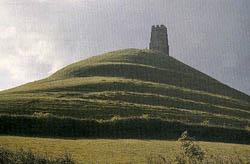If you want history, legend, mystery, a feeling
of "other-worldness", then go to Somerset to the ancient settlement of
Glastonbury and there you will find it all. It is a place full of legends, a
place of pilgrimage for Christians and for the followers of the New Age
philosophy. The early settlement was not the green, grassy  place
we see today. At the time of Christ the sea came up to the lower slopes of the Tor
and by the third century it had been replaced by a lake. Today this is the area
of the Somerset Levels controlled by a system of drains (water courses whose
levels are controlled.) Two thousand years ago it was a marshy, waterlogged area
with small villages built on islands, very much in the style of the crannogs of
Scotland and Ireland. The pyramid shaped Tor and its satellite hills which
overlook the present town have probably changed very little. One of these hills
- Wearyall- features in one of the legends of Glastonbury, that of the Holy
Thorn. The story is that Joseph of Arimathea planted his staff into the ground
and it took toot. From this sprang a thorn tree that flowered twice a year, at
Christmastime and in the early spring.
place
we see today. At the time of Christ the sea came up to the lower slopes of the Tor
and by the third century it had been replaced by a lake. Today this is the area
of the Somerset Levels controlled by a system of drains (water courses whose
levels are controlled.) Two thousand years ago it was a marshy, waterlogged area
with small villages built on islands, very much in the style of the crannogs of
Scotland and Ireland. The pyramid shaped Tor and its satellite hills which
overlook the present town have probably changed very little. One of these hills
- Wearyall- features in one of the legends of Glastonbury, that of the Holy
Thorn. The story is that Joseph of Arimathea planted his staff into the ground
and it took toot. From this sprang a thorn tree that flowered twice a year, at
Christmastime and in the early spring.
Of all the followers of Jesus Christ perhaps Joseph
of Arimathea was the most unlikely. From the Bible we discover that he was
wealthy and pious and a member of the Jewish Council, the Sanhedrin. Considering
that the council members were Jesus’ mortal enemies, Joseph’s allegiance was
unusual to say the least.. During the lifetime of Jesus, Joseph understandably,
to coin a modern phrase, maintained a low profile. After the Crucifixion, with
the Sabbath fast approaching and time being precious, Joseph went to Pilate to
ask for the body of Jesus. It was granted to him and he and Nicodemus prepared
it for burial with the usual Jewish rites. The stone tomb was very likely one
that Joseph had had built for himself. There would certainly not have been time
to search any distance for a tomb before the beginning of the Sabbath.
After this he slips out of history and into
legend. One version is that he had visited England previously in his capacity as
a merchant travelling with Phoenicians in their search for tin.. Another that he
was a relative of Mary and on one journey he had brought with him the young
Jesus of Nazareth. It has been suggested that this story was the inspiration for
William Blake’s "And did those feet in ancient times...." Yet
another version is that, having left Jerusalem, he joined Philip the Apostle in
Gaul and was sent by him to England with twelve disciples. They were received by
the king who gave them the island of Yniswitrin which was later called
Glastonbury. Here they built a wattle church, the forerunner of Glastonbury
Abbey. The simple wattle church was built where the abbey’s Lady Chapel later
stood. It was dedicated to the Virgin Mary and around 500 AD, Glastonbury had
become the first home of the cult of the Virgin in England. The Holy Grail
became Mary’s emblem and another of the Glastonbury legends is that Joseph
brought it with him after the crucifixion. The Grail was believed to have been
the cup used by Jesus at the last supper or that it held his blood collected at
the Crucifixion.
The little wattle chapel grew into the largest
and richest abbey in England. As with most religious foundations it had its ups
and downs. St. Patrick visited it and its most famous abbot was St. Dunstan
(940-56) who later became Archbishop of Canterbury. In the sixteenth century
Glastonbury was in dispute with Canterbury about the possession of St. Dunstan’s
relics and each claimed to be the oldest foundation. It was at this time of
crisis that the Joseph legends seemed to have appeared. His cult was developed
by Abbot Beere who inserted a crypt into the Lady Chapel and established a
shrine dedicated to St. Joseph. Also about this time, Glastonbury’s other
famous legends were flowering: those of King Arthur, whose grave had supposedly
been discovered a few centuries earlier. The legends of Joseph were, and are,
passionately believed to be true. However, it has to be said that William of
Malmesbury and all the other early sources do not mention the Glastonbury Legend
(as it was called). John of Glastonbury writing his "History" at the
beginningof the 15th century includes Joseph, St. Patrick and Arthur but does
not mention the Grail story in his version of the Legend .Joseph’s own grave
was believed to have been in Glastonbury but was never found
In the story of the Holy Thorn, Joseph planted
his staff on Wearyall Hill and here it blossomed and flourished. Down the ages
pilgrims came and took away with them leaves and cuttings as souvenirs. Some of
these cuttings were rooted around Glastonbury, outside the chapel of St. Patrick
in the abbey and at the front of St. John’s church. The tree on the hill
flourished with its double trunk and winter flowers until Elizabethan times,
when it was attacked by a Protestant zealot with an axe. The story goes that he
felled one part but while hacking at the second, the axe rebounded hitting him
on the leg. A chip of wood flew in his eye blinding him. He then wisely left the
tree alone! The tree survived until the Civil War.
Did Joseph of Arimathea come to Glastonbury and
plant his staff on Wearyall Hill and did it take root there? He was wealthy and
his wealth very possibly came from trade and, therefore, he would have had
access to ships to take him across the seas to Britain. There was trade between
the Phoenicians and Britain at this time. He would have had the incentive to
leave Jerusalem once the news got about that he had given up his tomb to the
Nazarene. His colleagues on the Sanhedrin would certainly have taken a very dim
of view of that!
 Finally
the thorn itself; it is not the common thorn of Britain which flowers only in
the spring. The Glastonbury Thorn flowers in early January which is the
time of the old Christmas Day. The fact that not many of the offsprings of the
old tree survive indicates that it was not natural to these shores. There is a
thorn - "Cratagus aronia" which grows in Asia, around Jerusalem and on
the Mount of Olives - whose wood was often used for shepherds’ crooks and
staffs. There were Christians among the Romano-British centuries before Columba
and Augustine brought the word of God back to these shores. Who brought the good
news to them? Joseph of Arimathea, perhaps?- it is certainly possible!
Finally
the thorn itself; it is not the common thorn of Britain which flowers only in
the spring. The Glastonbury Thorn flowers in early January which is the
time of the old Christmas Day. The fact that not many of the offsprings of the
old tree survive indicates that it was not natural to these shores. There is a
thorn - "Cratagus aronia" which grows in Asia, around Jerusalem and on
the Mount of Olives - whose wood was often used for shepherds’ crooks and
staffs. There were Christians among the Romano-British centuries before Columba
and Augustine brought the word of God back to these shores. Who brought the good
news to them? Joseph of Arimathea, perhaps?- it is certainly possible!
Barbara Hothersall
 place
we see today. At the time of Christ the sea came up to the lower slopes of the Tor
and by the third century it had been replaced by a lake. Today this is the area
of the Somerset Levels controlled by a system of drains (water courses whose
levels are controlled.) Two thousand years ago it was a marshy, waterlogged area
with small villages built on islands, very much in the style of the crannogs of
Scotland and Ireland. The pyramid shaped Tor and its satellite hills which
overlook the present town have probably changed very little. One of these hills
- Wearyall- features in one of the legends of Glastonbury, that of the Holy
Thorn. The story is that Joseph of Arimathea planted his staff into the ground
and it took toot. From this sprang a thorn tree that flowered twice a year, at
Christmastime and in the early spring.
place
we see today. At the time of Christ the sea came up to the lower slopes of the Tor
and by the third century it had been replaced by a lake. Today this is the area
of the Somerset Levels controlled by a system of drains (water courses whose
levels are controlled.) Two thousand years ago it was a marshy, waterlogged area
with small villages built on islands, very much in the style of the crannogs of
Scotland and Ireland. The pyramid shaped Tor and its satellite hills which
overlook the present town have probably changed very little. One of these hills
- Wearyall- features in one of the legends of Glastonbury, that of the Holy
Thorn. The story is that Joseph of Arimathea planted his staff into the ground
and it took toot. From this sprang a thorn tree that flowered twice a year, at
Christmastime and in the early spring.
 Finally
the thorn itself; it is not the common thorn of Britain which flowers only in
the spring. The Glastonbury Thorn flowers in early January which is the
time of the old Christmas Day. The fact that not many of the offsprings of the
old tree survive indicates that it was not natural to these shores. There is a
thorn - "Cratagus aronia" which grows in Asia, around Jerusalem and on
the Mount of Olives - whose wood was often used for shepherds’ crooks and
staffs. There were Christians among the Romano-British centuries before Columba
and Augustine brought the word of God back to these shores. Who brought the good
news to them? Joseph of Arimathea, perhaps?- it is certainly possible!
Finally
the thorn itself; it is not the common thorn of Britain which flowers only in
the spring. The Glastonbury Thorn flowers in early January which is the
time of the old Christmas Day. The fact that not many of the offsprings of the
old tree survive indicates that it was not natural to these shores. There is a
thorn - "Cratagus aronia" which grows in Asia, around Jerusalem and on
the Mount of Olives - whose wood was often used for shepherds’ crooks and
staffs. There were Christians among the Romano-British centuries before Columba
and Augustine brought the word of God back to these shores. Who brought the good
news to them? Joseph of Arimathea, perhaps?- it is certainly possible!